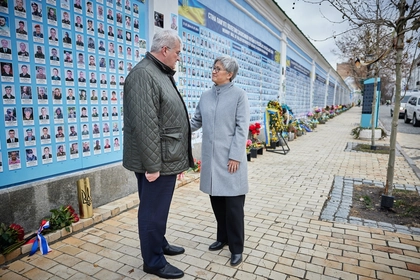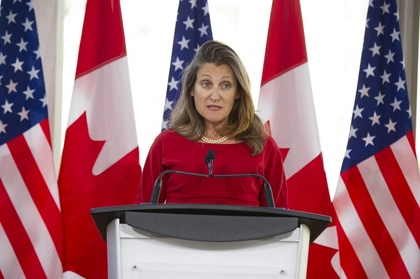As the US and Britain discuss allowing Ukraine to use Western weapons to strike deep within Russia, some US officials are deeply skeptical that doing so would make a significant difference in Kyiv’s battle against Russian invaders.
British Prime Minister Keir Starmer arrived in Washington on Friday (13 September) to discuss with US President Joe Biden whether to give Ukraine approval to use NATO-supplied weapons to hit targets far beyond Ukraine’s borders, something the US administration has so far not been willing to allow in the 2-1/2-year-old conflict.
JOIN US ON TELEGRAM
Follow our coverage of the war on the @Kyivpost_official.
US officials noted that Ukraine already has the capability to hit targets in Russia using drones. US-supplied long-range ATACMS missiles would enhance that capability, but they are too costly and limited in number to reshape the dynamic, they said.
Moreover, the Kremlin has largely moved perhaps the most immediate threat — Russian warplanes launching glide bombs — beyond the range of the US missiles, the US officials said.
They also believe Kyiv should focus on halting a Russian advance in Ukraine’s east.
For Biden, the decision is not just tactical. It raises questions about whether authorizing such strikes might risk a direct war between NATO and Russia.
Russia warned at the United Nations on Friday that authorizing Ukraine to fire missiles far into Russia would turn NATO into “a direct party to hostilities against a nuclear power,” and Russian President Vladimir Putin has said that such a move would alter the scope of the conflict.

Australian Foreign Minister Visits Kyiv, Confirms Reopening of Embassy
White House spokesman John Kirby said on Friday the United States took such threats seriously, even as he acknowledged there was nothing new in Putin’s rhetoric.
Democratic US Representative Jason Crow, a member of the House intelligence and foreign affairs committees, downplayed the threat of Putin attacking Poland or other NATO members in retaliation.
“I don’t believe there’s any indication that Vladimir Putin has an interest in picking a fight with NATO,” he told Reuters, pointing to Russia’s massive losses of men and armor in Ukraine. “To the contrary, I think he is avoiding a NATO confrontation.”
What would Ukraine strike in Russia?
Speaking at Ramstein Air Base in Germany a week ago, Ukrainian President Volodymyr Zelenskyy urged the United States and its allies to ignore Russia’s red lines and give permission for long-range strikes into Russia as a way to pressure Moscow.
“We need to have this long-range capability not only on the occupied territory of Ukraine, but also on Russian territory … so that Russia is motivated to seek peace,” Zelenskyy said.
Two European diplomats, speaking on condition of anonymity, said Ukraine has submitted to the US and Britain a list of potential targets inside Russia that could be hit if allowed.
The discussion about whether to ease restrictions on Ukraine echoes prior debates about Kyiv’s pleas for other capabilities it hoped would give it an edge against Russian forces, from F-16 fighter jets to Abrams tanks.
“You’ve heard this (debate) before,” said one US official, speaking to Reuters on condition of anonymity.
Ukrainians initially wanted to use US-supplied ATACMS long-range missiles to hit Russian airbases, officials said.
But the Pentagon has said 90% of Russian aircraft launching glide bombs, one of the top threats for Ukraine, are at airfields at least 300 kilometres away from Ukrainian-controlled territory. That puts them out of range of the ATACMS.
Ukraine now wants to use the missiles to strike Russian military command and control hubs, fuel and weapons depots and troop concentrations, officials said.
In addition to US ATACMS, Kyiv wants to carry out long-range strikes into Russia using Storm Shadow missiles provided by Britain and the nearly identical French SCALP missiles.
Although Britain is expected to seek US approval before lifting its restrictions on Storm Shadow missiles, a French diplomatic source said Paris did not need authorization from Washington for Ukraine to use French missiles.
Focus on ground war
Another US concern is that focusing on long-range strikes downplays what could be a bigger immediate threat: Russia’s advances on the ground inside Ukrainian territory toward the strategic city of Pokrovsk. US officials believe the loss of the city would deal a significant blow.
Analysts said Russia has many response options, short of direct war with NATO, if the United States or its allies allow Ukraine to unleash strikes deep into Russia.
In June, Putin spoke of possibly arming the West’s enemies with Russian weapons to strike Western targets abroad, and of deploying conventional missiles within striking distance of the United States and its European allies.
Ulrich Kuehn, an arms expert at the Institute for Peace Research and Security Policy in Hamburg, said he did not rule out Putin choosing to send some kind of nuclear message – for example testing a nuclear weapon in an effort to cow the West.
Still, Crow, the US lawmaker, argued that Putin was in a weaker position after the Ukraine invasion, and any major response from Moscow created risks for him.
“Vladimir Putin is not 10-feet tall. We have seen that repeatedly over the last couple of years. He’s very vulnerable, and frankly, he’s in a position of significant weakness,” said Crow.
Reprinted from Euractiv. You can find the original here.
You can also highlight the text and press Ctrl + Enter






